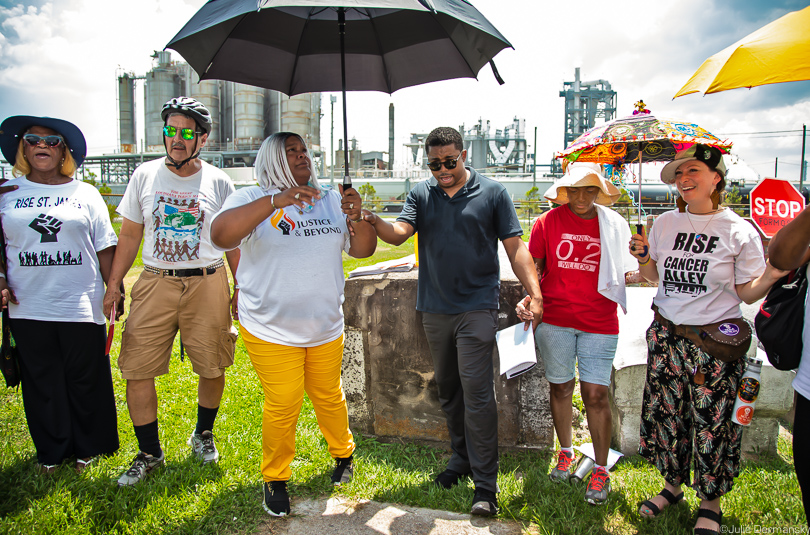On June 3, at the end of a five-day march through stifling heat in Louisiana’s Cancer Alley, activists fighting against environmental racism reached their goal of bringing attention to their area’s injustices to the state capitol.
The Coalition Against Death Alley (CADA), a group of Louisiana-based residents and members of various local and state organizations, were met with praise on the steps of the capitol building by State Representative Randal Gaines, the head of the Louisiana Black Caucus.
He told the group, which made its way some 50 miles by bus and — on foot — from St. John the Baptist Parish to Baton Rouge, that he was proud of them and that he had spoken with Governor John Bel Edwards’ chief of staff, who told him she wants to set up a meeting with the leaders of CADA.
“Our children are going to inherit the problems that we don’t solve today. They will inherit those tomorrow,” Gaines said, addressing the group assembled on the capitol building’s steps.
State Representative Randal Gaines
Lt. General Russel Honoré, founder of the Green Army, praised the marchers, too. “What they did was courageous — marchers were facing multiple threats,” Honoré told me during a call after the march. “We are in Louisiana,“ he said, “a state not known to have a great record when it comes to civil rights.”
Though he doesn’t agree with all of the CADA’s stances, he respects the group for using their First Amendment rights. “A lot of important things happen because of marching,” including basic civil rights. “It is a crying damn shame that people face getting arrested for fighting for clean air and water,” Honoré said, adding that at some point he could see himself getting arrested in the battle for clean air.
Over the course of five days, the group marched through parts of Louisiana’s “Petrochemical Corridor,” an 80-mile stretch along the Mississippi River lined with petrochemical plants and refineries known by some as “Cancer Alley.” The coalition has rebranded the area “Death Alley” due to the above-average number of deaths from cancer.
The coalition stands in opposition to environmental racism that it says the state propagates by situating the worst polluting industrial plants in predominantly African American communities. Their claim is backed up by research published in March in the journal the Proceedings of the National Academy of Sciences, which found a connection between race and environmental hazards. The study concluded that, on average, non-Hispanic whites inhale far less air pollution, relative to their consumption of goods and services that contributes to it, than blacks and Hispanics, respectively.
Facing Road Blocks
The march kicked off at an elementary school in St. John the Baptist Parish near the fence line of the Denka Performance Elastomer neoprene manufacturing plant. The plant emits chloroprene, a chemical recently reclassified as a likely human carcinogen by the U.S. Environmental Protection Agency (EPA) at levels that greatly exceed the agency’s recommended standard.
Marchers set off on their five day journey at the 5th Ward Elementary School where children are exposed to air pollution from a local synthetic rubber plant.
CADA members stop in front of the Whitney Plantation, now a museum focused on slavery, to pray and lambast the museum’s owner for not welcoming them on the grounds.
The second day of the march, CADA members put the march on hold and spent the morning in a Baton Rouge courtroom at an emergency hearing challenging the state’s denial of permits to march over two bridges that cross the Mississippi River ― the I-10 Bridge in Baton Rouge and the Sunshine Bridge in St. James Parish. When the hearing was over, the group headed to St. James Parish to resume the march in an area where numerous multinational corporations plan to build more petrochemical plants.
A child braves the heat to protest against air pollution in Cancer Alley in St. James, with a group spanning four generations.
CADA marchers board a bus on Burton Lane in St. James at the end of the second day of the march.
They received word that the judge ruled against them before they resumed the march. The judge let the permit denial stand, citing a ruling based on a 1960 law about obstructing highway commerce across the bridges, and set a hearing date for June 12. Anyone who chose to defy the ruling faced a possible felony charge that carries up to 15 years imprisonment.
Honoré was outraged by the court’s ruling. He pointed out that the operator of a barge that hit the Sunshine Bridge, resulting in the bridge’s closure for weeks, wasn’t even fined, yet citizens participating in civil disobedience are being threatened with a 15-year felony charge.
“It is extremely disturbing that people who want to walk across a bridge in one of the most fundamental forms of peaceful protest are facing up to 15 years in prison,” said Pam Spees of the Center for Constitutional Rights, attorney for the marchers. “These laws were enacted to discourage and control civil rights protesters in the 1960s. And they’re being deployed now to discourage this generation of people doing everything they can to get the message out about the horrific situation in what is widely known as Cancer Alley.”
Sharon Lavigne, founder of the community group RISE St. James, said, “They’re threatening to charge us with a 15-year felony because we would inconvenience drivers over the bridge and disturb their quality of life, when all we’re trying to do is bring attention to the fact that people are dying and our communities and our history are in danger of being erased.”
Robert Taylor and Sharon Lavigne at the front of the march in St. James Parish.
CADA members at the foot of the Sunshine Bridge, which they did not receive a permit to cross.
Lavigne thinks the threat was a scare tactic. “It worked this time,“ she told me. She was prepared to face a misdemeanor charge and march over the bridge if the permit was denied, but wasn’t prepared to face a felony charge just yet ― for her, the threat worked. “But it won’t work next time ― we will come back stronger.”
Crossing Bridges
Anne Rolfes, founder of the Louisiana Bucket Brigade, talking to CADA members and supporters before marching began on June 1.
Members of the climate-focused Sunrise Movement marching with CADA on River Road in St. James Parish to the site of Formosa’s planned petrochemical manufacturing complex.
On the third day, the marchers passed the site of the proposed Formosa petrochemical complex, which is less than two miles from Lavigne’s house, before making their way to the foot of the Sunshine Bridge.
Police were on hand both to protect them from traffic and arrest them if they decided to march over the bridge. At a press conference, the group announced that they would not attempt to cross the bridge that day. But a second march is potentially in the works, at which time they would challenge the court’s ruling if they still cannot get a permit.
CADA members turn their backs on the governor’s mansion in Baton Rouge.
The group crossed the bridge in a bus and took their protest to the Louisiana governor’s mansion, where they protested across from the mansion’s entrance.
From there, they headed to Geismer, in Ascension Parish, where they marched by chemical plants.
CADA members marching in Geismar, Louisiana.
Grave Circumstances
On the fourth day, the group held a prayer at the Reveille Town Cemetery in Plaquemine, Louisiana, which is within the fence line of the Westlake Chemical plant. The site has become grounds for an ongoing legal battle between Janice Dickerson, a longtime civil rights activist who has family buried in the cemetery, and the company that controls the cemetery. Dickerson asserts that, according to an old deed, the property was purchased by Dickerson’s third great-grandfather, Robert Taylor, under the Mt. Zion Baptist Association, which is currently listed as the owner.
Janice Dickerson, Vivian Ann Craig Chiphe, Robert Taylor and his daughter, Tish Taylor, in the Reveille Town Cemetery.
Prayer held by members of CADA and supporters at the Reveille Town Cemetery.
However, Westlake says it has maintained the cemetery located within its property since 1990. Dickerson says her family has also helped maintain the lot and should be entitled to the property since they’re the purchaser’s descendants.
CADA members were outraged that family members must seek permission from a company to gain access to the graves of loved ones. The group also tried to access a cemetery within the fenceline of a Dow Chemical Plant nearby. Their bus was denied access to the graveyard. After being turned away, the group crossed the I-10 bridge — again, on bus — and then held a press conference next to it in Baton Rouge.
Robert Taylor speaking next to the I-10 Bridge
Delivering a Message to Louisiana’s Governor
Wrapping up the group’s protest on the fifth day, CADA leaders from neighborhoods impacted by toxic air emissions, including Lavigne and Robert Taylor, director of the Concerned Citizens of St. John, went to the governor’s office to deliver a letter with the following demands:
- No new petrochemical plants in the Mississippi River parishes.
- Ban all industrial emissions within five miles of all public areas.
- Reduce emissions at Denka to remain under the recommended limit, or shut down the plant.
- Shut down the Mosaic fertilizer plant in St. James Parish and remove the radioactive waste that’s posing a public health risk.
- Cover health costs incurred by residents for illnesses caused or exacerbated by exposure to industrial pollution.
- End the industrial tax exemption program.
Robert Taylor and Sharon Lavigne climbing the steps of the Capitol to deliver a letter to Governor John Bel Edwards.
Robert Taylor and Sharon Lavigne at the reception desk of Governor Edwards’ office.
In the reception area of the governor’s office, Taylor and Lavigne met with an aide to deliver the letter, and attempted to get an appointment to meet directly with the governor. The aide explained there was a process, and an appointment couldn’t be made that day, but could be scheduled later.
Taylor and Lavigne slipped out while other CADA members remained in the reception area chanting: “We won’t vacate without a date.” The leaders left, saying they were tired and wanted to preserve their energy because their fight is far from over.
Taylor is skeptical that meeting with the governor will have any impact. “The governor must be aware of what is going on with the chloroprene emissions,” he told me on a call after the march. “If he isn’t aware of the scientific evidence provided by the EPA that we are being poisoned, he is in dereliction of his duty.”
But Lavigne holds out hope that if Governor Edwards would meet with them in their communities, he would better understand how his decisions impact them and would change course in his administration’s welcoming of new petrochemical industry and light regulatory touch.
Updated 6/6/19: This story has been updated to correct a typo, the name of the Sunrise Movement, and the name of the town Geismar.
Main image: Coalition Against Death Alley on the steps of the State Capitol at the end of their five day march. Credit: All photos and videos by Julie Dermansky for DeSmog
Subscribe to our newsletter
Stay up to date with DeSmog news and alerts





















